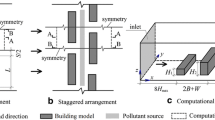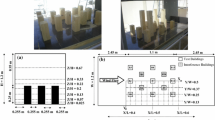Abstract
Studying the mechanism of pollutant transport around an isolated building is essential to address the environmental issue of air pollution around buildings and to understand the intricate process of pollutant dispersion in urban environments. In this paper, an effective numerical approach is used to study the effects of building heights and widths on airflow and pollutant dispersion around an isolated building. The source of pollutants is behind the building. The pollutant is confined to the lower areas as a result of small vortices behind the low-rise buildings, and transported to the wake area. Whereas high-rise buildings make the pollutant move to an upper region. At the pedestrian level, the wake area of the lower building stores more pollution. Therefore, the environment around the low-rise buildings may be more hazardous. The concentration of pollutants is greater at higher altitudes around wider buildings. Pollutants are transferred to the sides of wider buildings at the pedestrian level, leading to lower concentrations in the wake-central area. A wider building poses a greater lateral dangerous-area, while a narrower building results in a longer central wake area that is hazardous.
Similar content being viewed by others
Abbreviations
- b :
-
Side of building
- c :
-
Concentration
- C μ, C d1, C d2 :
-
Model constant
- D :
-
Molecular diffusion coefficient
- d w :
-
Distance to the closest wall
- ELES:
-
Embedded large-eddy simulation
- f d, F 1, F 2, f d1, f d2 :
-
Shielding function
- h :
-
Height of building
- h max :
-
Maximum edge length of the cell
- J i :
-
Turbulent concentration flux
- k :
-
Turbulence kinetic energy
- LES:
-
Large-eddy simulation
- NMSE:
-
Normalized mean square error
- p :
-
Pressure
- P k :
-
Generation of turbulence kinetic energy
- PLES:
-
Production-limited eddy simulation
- P ples :
-
Production term in the PLES model
- RANS:
-
Reynolds-averaged Navier-Stokes
- S :
-
Modulus of the mean rate of strain tensor
- Sc t :
-
Turbulent Schmidt number
- S ij :
-
Strain rate tensor
- S ij d :
-
Strain rate tensor in WALE model
- SGS:
-
Subgrid scale
- SST:
-
Shear Stress Transport
- t :
-
Time
- TKE:
-
Turbulence kinetic energy
- u h :
-
Inflow velocity at height of building
- u i, u j :
-
Component of the velocity
- URANS:
-
Unsteady Reynolds-averaged Navier-Stokes
- V :
-
Cell volume
- w :
-
Width of the building
- WALE:
-
Wall-adapting local eddy-viscosity
- x, y, z :
-
Coordinate axis
- α, β, β*, σ k, σ ω, σ ω2 :
-
Model constants
- δ ij :
-
Kronecker delta
- ε :
-
Turbulence dissipation rate
- κ :
-
Von Kármán constant
- μ :
-
Viscosity
- μ sgs :
-
Subgrid scale eddy viscosity
- μ t :
-
Turbulent viscosity
- ν :
-
Kinematic viscosity
- ρ :
-
Density
- Ω :
-
Magnitude of vorticity tensor
- ω :
-
Specific dissipation rate
- ¯:
-
Ensemble averaged
- i,j:
-
Vector
References
Ai ZT, Mak M (2015) Large-eddy Simulation of flow and dispersion around an isolated building: Analysis of influencing factors. Computers & Fluids 118:89–100, DOI: https://doi.org/10.1016/j.compfluid.2015.06.006
An K, Fung JCH (2018) An improved SST k-ω model for pollutant dispersion simulations within an isothermal boundary layer. Journal of Wind Engineering and Industrial Aerodynamics 179:369–384, DOI: https://doi.org/10.1016/j.jweia.2018.06.010
Bazdidi-Tehrani F, Gholamalipour P, Kiamansouri M, Jadidi M (2019) Large eddy simulation of thermal stratification effect on convective and turbulent diffusion fluxes concerning gaseous pollutant dispersion around a high-rise model building. Journal of Building Performance Simulation 12(1):97–116, DOI: https://doi.org/10.1080/19401493.2018.1486886
Blocken B, Stathopoulos T, Van Beeck J (2016) Pedestrian-level wind conditions around buildings: Review of wind-tunnel and CFD techniques and their accuracy for wind comfort assessment. Building and Environment 100:50–81, DOI: https://doi.org/10.1016/j.buildenv.2016.02.004
Cui PY, Chen WQ, Wang JQ, Zhang JH, Huang YD, Tao WQ (2022) Numerical studies on issues of Re-independence for indoor airflow and pollutant dispersion within an isolated building. Building Simulation 15(7):1259–1276, DOI: https://doi.org/10.1007/s12273-021-0846-z
Ding P, Zhou X (2022) A DDES model with subgrid-scale eddy viscosity for turbulent flow. Journal of Applied Fluid Mechanics 15(3):831–842, DOI: https://doi.org/10.47176/JAFM.15.03.33238
Ding P, Zhou X, Wu H, Chen Q (2022) An efficient numerical approach for simulating airflows around an isolated building. Building and Environment 210:108709, DOI: https://doi.org/10.1016/j.buildenv.2021.108709
Du Y, Mak CM, Kwok K, Tse KT, Lee TC, Ai Z, Niu J (2017) New criteria for assessing low wind environment at pedestrian level in Hong Kong. Building and Environment 123:23–36, DOI: https://doi.org/10.1016/j.buildenv.2017.06.036
Foroutan H, Tang W, Heist DK, Perry SG, Brouwer LH, Monbureau E M (2018) Numerical analysis of pollutant dispersion around elongated buildings: An embedded large eddy simulation approach. Atmospheric Environment 187:117–130, DOI: https://doi.org/10.1016/j.atmosenv.2018.05.053
Gousseau P, Blocken B, Van Heijst GJF (2012) Large-Eddy Simulation of pollutant dispersion around a cubical building: Analysis of the turbulent mass transport mechanism by unsteady concentration and velocity statistics. Environmental Pollution 167:47–57, DOI: https://doi.org/10.1016/j.envpol.2012.03.021
Guo GZ, Yu Y, Kwok KCS, Zhang Y (2022) Air pollutant dispersion around high-rise buildings due to roof emissions. Building and Environment 219:109215, DOI: https://doi.org/10.1016/j.buildenv.2022.109215
Hang J, Li Y, Sandberg M, Buccolieri R, Di Sabatino S (2012) The influence of building height variability on pollutant dispersion and pedestrian ventilation in idealized high-rise urban areas. Building and Environment 56:346–360, DOI: https://doi.org/10.1016/j.buildenv.2012.03.023
Jadidi M, Bazdidi-Tehrani F, Kiamansouri M (2016) Embedded large eddy simulation approach for pollutant dispersion around a model building in atmospheric boundary layer. Environmental Fluid Mechanics 16(3):575–601, DOI: https://doi.org/10.1007/s10652-016-9444-5
Jadidi M, Bazdidi-Tehrani F, Kiamansouri M (2018) Scale-adaptive simulation of unsteady flow and dispersion around a model building: Spectral and POD analyses. Journal of Building Performance Simulation 11(2):241–260, DOI: https://doi.org/10.1080/19401493.2017.1326165
Jiang G, Yoshie R (2020) Side ratio effects on flow and pollutant dispersion around an isolated high-rise building in a turbulent boundary layer. Building and Environment 180:107078, DOI: https://doi.org/10.1016/j.buildenv.2020.107078
Keshavarzian E, Jin R, Dong K, Kwok KCS (2021) Effect of building cross-section shape on air pollutant dispersion around buildings. Building and Environment 197:107861, DOI: https://doi.org/10.1016/j.buildenv.2021.107861
Keshavarzian E, Jin R, Dong K, Kwok KCS, Zhang Y, Zhao M (2020) Effect of pollutant source location on air pollutant dispersion around a high-rise building. Applied Mathematical Modelling 81:582–602, DOI: https://doi.org/10.1016/j.apm.2020.01.019
Lateb M, Meroney RN, Yataghene M, Fellouah H, Saleh F, Boufadel MC (2016) On the use of numerical modelling for near-field pollutant dispersion in urban environments-A review. Environmental Pollution 208:271–283, DOI: https://doi.org/10.1016/j.envpol.2015.07.039
Li Y, Stathopoulos T (1997) Numerical evaluation of wind-induced dispersion of pollutants around a building. Journal of Wind Engineering and Industrial Aerodynamics 67:757–766, DOI: https://doi.org/10.1016/S0167-6105(97)00116-5
Liu J, Niu J (2016) CFD simulation of the wind environment around an isolated high-rise building: An evaluation of SRANS, LES and DES models. Building and Environment 96:91–106, DOI: https://doi.org/10.1016/j.buildenv.2015.11.007
Ma H, Zhou X, Tominaga Y, Gu M (2022) CFD simulation of flow fields and pollutant dispersion around a cubic building considering the effect of plume buoyancies. Building and Environment 208:108640, DOI: https://doi.org/10.1016/j.buildenv.2021.108640
Mathey F, Cokljat D, Bertoglio JP, Sergent E (2006) Assessment of the vortex method for large eddy simulation inlet conditions. Progress in Computational Fluid Dynamics, An International Journal 6(1–3): 58–67, DOI: https://doi.org/10.1504/PCFD.2006.009483
Menter FR (1994) Two-equation eddy-viscosity turbulence models for engineering applications. AIAA Journal 32(8):1598–1605, DOI: https://doi.org/10.2514/3.12149
Nicoud F, Ducros F (1999) Subgrid-scale stress modelling based on the square of the velocity gradient tensor. Flow Turbulence and Combustion 62(3):183–200, DOI: https://doi.org/10.1023/A:1009995426001
Potsis T, Tominaga Y, Stathopoulos T (2023) Computational wind engineering: 30 years of research progress in building structures and environment. Journal of Wind Engineering and Industrial Aerodynamics 234:105346, DOI: https://doi.org/10.1016/j.jweia.2023.105346
Tominaga Y, Mochida A, Shirasawa T, Yoshie R, Kataoka H, Harimoto K, Nozu T (2004) Cross comparisons of CFD results of wind environment at pedestrian level around a high-rise building and within a building complex. Journal of Asian Architecture and Building Engineering 3(1):63–70, DOI: https://doi.org/10.3130/jaabe.3.63
Tominaga Y, Mochida A, Yoshie R, Kataoka H, Nozu T, Yoshikawa M, Shirasawa T (2008) AIJ guidelines for practical applications of CFD to pedestrian wind environment around buildings. Journal of Wind Engineering and Industrial Aerodynamics 96(10):1749–1761, DOI: https://doi.org/10.1016/j.jweia.2008.02.058
Tominaga Y, Stathopoulos T (2009) Numerical simulation of dispersion around an isolated cubic building: Comparison of various types of k-ε models. Atmospheric Environment 43(20):3200–3210, DOI: https://doi.org/10.1016/j.atmosenv.2009.03.038
Tominaga Y, Stathopoulos T (2010) Numerical simulation of dispersion around an isolated cubic building: Model evaluation of RANS and LES. Building and Environment 45(10):2231–2239, DOI: https://doi.org/10.1016/j.buildenv.2010.04.004
Tominaga Y, Stathopoulos T (2011) CFD modeling of pollution dispersion in a street canyon: Comparison between LES and RANS. Journal of Wind Engineering and Industrial Aerodynamics 99(4):340–348, DOI: https://doi.org/10.1016/j.jweia.2010.12.005
Tominaga Y, Stathopoulos T (2017) Steady and unsteady RANS simulations of pollutant dispersion around isolated cubical buildings: Effect of large-scale fluctuations on the concentration field. Journal of Wind Engineering and Industrial Aerodynamics 165:23–33, DOI: https://doi.org/10.1016/j.jweia.2017.02.001
Tominaga Y, Stathopoulos T (2018) CFD simulations of near-field pollutant dispersion with different plume buoyancies. Building and Environment 131:128–139, DOI: https://doi.org/10.1016/j.buildenv.2018.01.008
van Hooff T, Blocken B, Tominaga Y (2017) On the accuracy of CFD simulations of cross-ventilation flows for a generic isolated building: Comparison of RANS, LES and experiments. Building and Environment 114:148–165, DOI: https://doi.org/10.1016/j.buildenv.2016.12.019
Yoshie R (2016) Wind tunnel experiment and large eddy simulation of pollutant/thermal dispersion in non-isothermal turbulent boundary layer. In Advanced Environmental Wind Engineering (pp. 167–196). Springer, DOI: https://doi.org/10.1007/978-4-431-55912-2_9
Yoshie R, Jiang G, Shirasawa T, Chung J (2011) CFD simulations of gas dispersion around high-rise building in non-isothermal boundary layer. Journal of Wind Engineering and Industrial Aerodynamics 99(4):279–288, DOI: https://doi.org/10.1016/j.jweia.2011.01.006
Yu Y, Kwok KCS, Liu XP, Zhang Y (2017) Air pollutant dispersion around high-rise buildings under different angles of wind incidence. Journal of Wind Engineering and Industrial Aerodynamics 167:51–61, DOI: https://doi.org/10.1016/j.jweia.2017.04.006
Zhang Y, Kwok KCS, Liu XP, Niu JL (2015) Characteristics of air pollutant dispersion around a high-rise building. Environmental Pollution 204:280–288, DOI: https://doi.org/10.1016/j.envpol.2015.05.004
Zhou X, Ying A, Cong B, Kikumoto H, Ooka R, Kang L, Hu H (2021) Large eddy simulation of the effect of unstable thermal stratification on airflow and pollutant dispersion around a rectangular building. Journal of Wind Engineering and Industrial Aerodynamics 211: 104526, DOI: https://doi.org/10.1016/j.jweia.2021.104526
Acknowledgments
This work is supported by the National Natural Science Foundation of China (Grant No. 52078146). We also acknowledge the Network Center of Guangzhou University for providing HPC computing resources.
Author information
Authors and Affiliations
Corresponding author
Rights and permissions
About this article
Cite this article
Ding, P., Zhou, X. Numerical Study on Effects of Heights and Widths on Airflow and Pollutant Dispersion around a Building. KSCE J Civ Eng 28, 1645–1656 (2024). https://doi.org/10.1007/s12205-024-0899-5
Received:
Revised:
Accepted:
Published:
Issue Date:
DOI: https://doi.org/10.1007/s12205-024-0899-5




